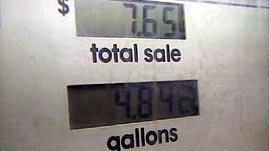Teachers' Domain - Digital Media for the Classroom and Professional Development
User: Preview


Source: FRONTLINE/NOVA: "What's Up with the Weather?"
There are times when our role as energy consumers is clear. For instance, when we fill our cars' fuel tanks, the amount of money we spend makes it obvious how much gas we are using. But what we seldom think about is the energy we consume by simply living our lives in a developed society. In this video segment adapted from NOVA/FRONTLINE, experts estimate the amount of energy that is burned during daily activities, and how much CO2 those activities contribute to the atmosphere.
Snapshot of US Energy Use (Audio Description) (Video)
The majority of the world's harnessed energy comes from burning fossil fuels. Fossil fuels are limited, nonrenewable resources formed from the remains of ancient plants and animals that have undergone chemical reactions over the course of millions of years. Since fossil fuels are being consumed faster than they are being produced, the resources that can be economically extracted will eventually run out.
Although less than 5 percent of the world's 6.45 billion people live in the United States, this small population consumes roughly 25 percent of the world's fossil fuel resources. This means that each American uses five times more energy than the average person in the world. In contrast, individuals in underdeveloped nations use 0 to 10 percent of the energy used by the average person in the world.
However, as less developed nations become industrialized, their inhabitants will require a larger share of the world's energy resources. In addition, as the global population continues to grow, the world's energy demands will increase. Some energy experts estimate that the world will run out of oil and natural gas resources within the next forty years or so. Coal will remain available for up to a thousand years, but coal isn't the best solution. It is the dirtiest of the fossil fuels, producing significant pollution during mining and combustion.
Fossil fuel consumption has also been implicated in global warming. When carbon-rich fossil fuels are burned to release their energy, they also release carbon dioxide gas (CO2). For each pound of carbon burned, almost four pounds of CO2 gas enter the atmosphere. Carbon dioxide is a greenhouse gas, and scientists think that an increase in its concentration in the atmosphere is contributing to global warming. Although scientists cannot predict all the effects of global warming, they are fairly certain that ecosystems, human health, agriculture, climate, and sea level will all be negatively affected.
Yet there is still hope for the future. New technologies, such as solar, wind, and fuel cell power, are already providing affordable renewable energy without contributing greenhouse gases to the atmosphere. Still, the best option is conservation. By December 2003, 120 nations had ratified the Kyoto Protocol, which calls for international reductions in greenhouse gas emissions. The primary method of reduction is a decrease in fossil fuel consumption through conservation. Most of the world's nations are moving in a direction that will stretch our global energy supply and minimize environmental stresses.
To learn about alternatives to fossil fuels, check out Energy Sources.
To learn how the world's current use of fossil fuels is contributing to global warming, check out Your Carbon Diet and Climate Change.
 Loading Standards
Loading Standards Teachers' Domain is proud to be a Pathways portal to the National Science Digital Library.
Teachers' Domain is proud to be a Pathways portal to the National Science Digital Library.
